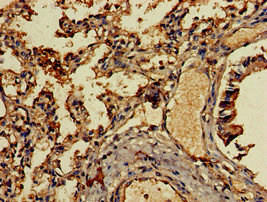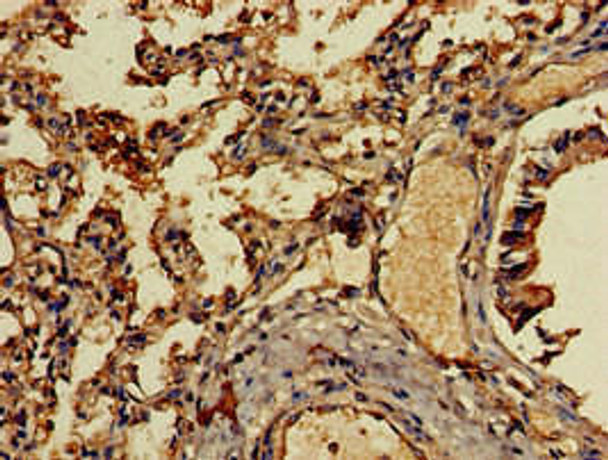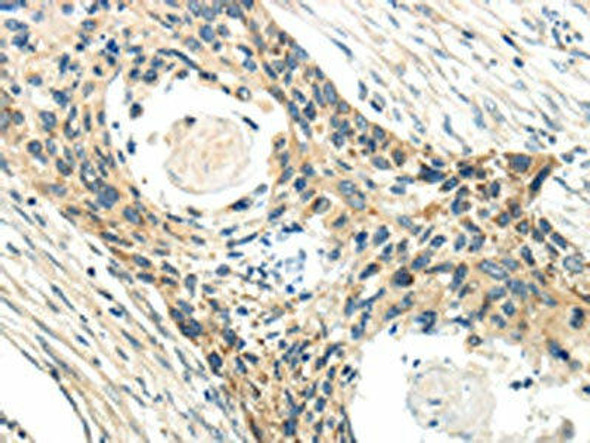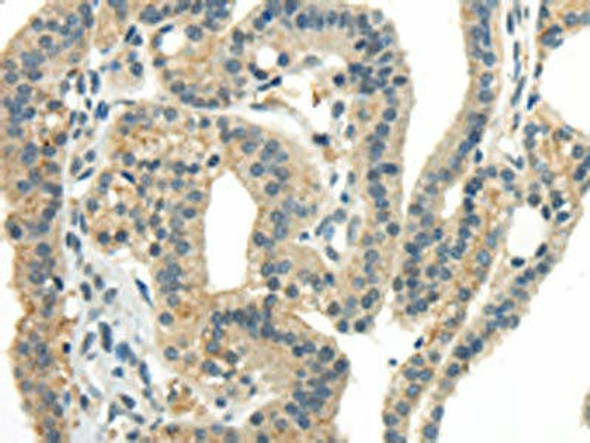Description
CCL13 Antibody (PACO50134)
The CCL13 Antibody (PAC050134) is a polyclonal antibody developed for research involving CCL13, a chemokine protein involved in immune responses and inflammatory processes. This antibody is raised in rabbits and has high reactivity with human samples, making it suitable for use in various research applications such as Western blotting.CCL13, also known as Monocyte chemoattractant protein 4 (MCP-4), is a chemokine that attracts monocytes, eosinophils, and lymphocytes to sites of inflammation. It plays a crucial role in the immune response and is implicated in various disease processes, including asthma, allergic reactions, and inflammatory conditions.
The CCL13 Antibody enables the detection and analysis of CCL13 protein in different cell types, making it a valuable tool for studies in immunology and inflammatory disease research.Understanding the function and regulation of CCL13 is essential for developing targeted therapies for diseases characterized by excessive inflammation and immune dysregulation. By using the CCL13 Antibody, researchers can uncover new insights into the role of CCL13 in immune responses and potentially identify novel therapeutic targets for treating inflammatory disorders.
| Antibody Name: | CCL13 Antibody (PACO50134) |
| Antibody SKU: | PACO50134 |
| Size: | 50ug |
| Host Species: | Rabbit |
| Tested Applications: | ELISA, IHC |
| Recommended Dilutions: | ELISA:1:2000-1:10000, IHC:1:20-1:200 |
| Species Reactivity: | Human |
| Immunogen: | Recombinant Human C-C motif chemokine 13 protein (17-81AA) |
| Form: | Liquid |
| Storage Buffer: | Preservative: 0.03% Proclin 300 Constituents: 50% Glycerol, 0.01M PBS, pH 7.4 |
| Purification Method: | >95%, Protein G purified |
| Clonality: | Polyclonal |
| Isotype: | IgG |
| Conjugate: | Non-conjugated |
 | Immunohistochemistry of paraffin-embedded human lung tissue using PACO50134 at dilution of 1:100. |
| Background: | Chemotactic factor that attracts monocytes, lymphocytes, basophils and eosinophils, but not neutrophils. Signals through CCR2B and CCR3 receptors. Plays a role in the accumulation of leukocytes at both sides of allergic and non-allergic inflammation. May be involved in the recruitment of monocytes into the arterial wall during the disease process of atherosclerosis. May play a role in the monocyte attraction in tissues chronically exposed to exogenous pathogens. |
| Synonyms: | C-C motif chemokine 13 (CK-beta-10) (Monocyte chemoattractant protein 4) (Monocyte chemotactic protein 4) (MCP-4) (NCC-1) (Small-inducible cytokine A13) [Cleaved into: C-C motif chemokine 13, long chain; C-C motif chemokine 13, medium chain; C-C motif chemokine 13, short chain], CCL13, MCP4 NCC1 SCYA13 |
| UniProt Protein Function: | CCL13: Chemotactic factor that attracts monocytes, lymphocytes, basophils and eosinophils, but not neutrophils. Signals through CCR2B and CCR3 receptors. Plays a role in the accumulation of leukocytes at both sides of allergic and non-allergic inflammation. May be involved in the recruitment of monocytes into the arterial wall during the disease process of atherosclerosis. May play a role in the monocyte attraction in tissues chronically exposed to exogenous pathogens. By IL1/interleukin-1 and TNF. Widely expressed. Found in small intestine, thymus, colon, lung, trachea, stomach and lymph node. Low levels seen in the pulmonary artery smooth muscle cells. Belongs to the intercrine beta (chemokine CC) family. |
| UniProt Protein Details: | Protein type:Secreted, signal peptide; Motility/polarity/chemotaxis; Chemokine; Secreted Chromosomal Location of Human Ortholog: 17q11.2 Cellular Component: extracellular space Molecular Function:chemokine activity; receptor binding Biological Process: cellular calcium ion homeostasis; regulation of cell shape; cell-cell signaling; eosinophil chemotaxis; cytoskeleton organization and biogenesis; immune response; signal transduction; inflammatory response; chemotaxis |
| NCBI Summary: | This antimicrobial gene is one of several Cys-Cys (CC) cytokine genes clustered on the q-arm of chromosome 17. Cytokines are a family of secreted proteins involved in immunoregulatory and inflammatory processes. The CC cytokines are proteins characterized by two adjacent cysteines. The cytokine encoded by this gene displays chemotactic activity for monocytes, lymphocytes, basophils and eosinophils, but not neutrophils. This chemokine plays a role in accumulation of leukocytes during inflammation. It may also be involved in the recruitment of monocytes into the arterial wall during artherosclerosis. [provided by RefSeq, Sep 2014] |
| UniProt Code: | Q99616 |
| NCBI GenInfo Identifier: | 3024128 |
| NCBI Gene ID: | 6357 |
| NCBI Accession: | Q99616.1 |
| UniProt Related Accession: | Q99616 |
| Molecular Weight: | |
| NCBI Full Name: | C-C motif chemokine 13 |
| NCBI Synonym Full Names: | C-C motif chemokine ligand 13 |
| NCBI Official Symbol: | CCL13 |
| NCBI Official Synonym Symbols: | NCC1; CKb10; MCP-4; NCC-1; SCYL1; SCYA13 |
| NCBI Protein Information: | C-C motif chemokine 13 |
| UniProt Protein Name: | C-C motif chemokine 13 |
| UniProt Synonym Protein Names: | CK-beta-10; Monocyte chemoattractant protein 4; Monocyte chemotactic protein 4; MCP-4; NCC-1; Small-inducible cytokine A13Cleaved into the following 3 chains:C-C motif chemokine 13, long chain; C-C motif chemokine 13, medium chain; C-C motif chemokine 13, short chain |
| Protein Family: | Meiotic coiled-coil protein |
| UniProt Gene Name: | CCL13 |
| UniProt Entry Name: | CCL13_HUMAN |
| Secondary Antibody |
| Anti-HRP Goat Anti-Rabbit IgG (H+L) Antibody (CABS014) |
| Recommended Products |
| Anti-FITC Goat Anti-Rabbit IgG (H+L) Antibody (CABS011) |
| Anti-HRP-conjugated Beta Actin Antibody (CABC028) |










